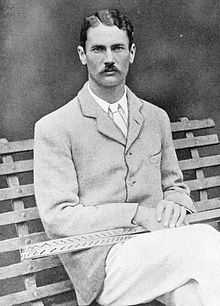Harold Mahony
 | |
| Full name | Harold Segerson Mahony |
|---|---|
| Country |
|
| Born |
13 February 1867 Edinburgh, Scotland |
| Died |
27 June 1905 (aged 38) County Kerry, Ireland |
| Height | 1.91 m (6 ft 3 in) |
| Turned pro | 1890 (amateur tour) |
| Retired | 1905 (due to death) |
| Singles | |
| Highest ranking | No. 2 (1896, Karoly Mazak)[1] |
| Grand Slam Singles results | |
| Wimbledon | W (1896) |
| US Open | 4R (1903) |
| Other tournaments | |
| Olympic Games |
|
| Doubles | |
| Other Doubles tournaments | |
| Olympic Games |
|
| Other Mixed Doubles tournaments | |
| Olympic Games |
|
| Olympic medal record | ||
|---|---|---|
| Men's tennis | ||
| Competitor for | ||
| Silver | 1900 Paris | Singles |
| Bronze | 1900 Paris | Doubles |
| Competitor for a | ||
| Silver | 1900 Paris | Mixed doubles |
| Wikimedia Commons has media related to Harold Mahony. |
Harold Segerson Mahony (13 February 1867 – 27 June 1905) was a Scottish-born Irish tennis player. He is best known for winning the Wimbledon Championships in 1896. He was born at 21 Charlotte Square, Edinburgh to Richard John Mahony, an Irish barrister and prominent landowner. The family had a home in Scotland but spent most of their time at Dromore Castle, in County Kerry, Ireland. Harold trained on a specially built tennis court at Dromore.[2]
Mahony made his Wimbledon debut in 1890 exiting in the first round. He reached the semi-final in 1891 and 1892.[2] Mahony spent some time in America in the mid-1890s, before returning to England and finally taking the Wimbledon crown in 1896. In the final he beat Wilfred Baddeley of Great Britain in five sets: 6–2, 6–8, 5–7, 8–6, 6–3.[2] Under the challenger system Mahony was entitled to defend the Wimbledon title in 1897 but this time he was beaten in the final in three straight sets by Reginald Doherty. He was the last Scottish born player to win a grand slam until Andy Murray won the US Open in 2012 and win Wimbledon until Murray won it in 2013. He was recognised as the third and last Irishman to win the Wimbledon singles. Wimbledon.[3]
He won the singles title at the British Covered Court Championships, played at the Queen's Club in London, in 1893 and successfully defended his title the following year. In 1895 he forfeited the defence of his title due to illness.[4]
At the 1900 Summer Olympics in Paris (France) he won a silver medal in the men's singles event and a bronze medal in the doubles tournament (for Great Britain and Ireland). Mahoney won the Kent Championships in 1899, defeating Wilberforce Eaves in the final, and in 1904, defeating Brame Hillyard in the final.[5]
Mahony was 1.91m (6 ft 3in) tall and possessed a formidable backhand. His forehand was less notable, his fellow-player, George Hillyard, wrote that he "never did acquire the right method of hitting the ball on the forehand".[2]
Mahony was killed on 25 June 1905, aged 38, in a bicycling accident while descending a steep hill near Caragh Lake in Co. Kerry.[2][4]
Mahony remained the last Scot to win the men's singles title at Wimbledon, until the triumph of Andy Murray at the 2013 championships; a point raised by the Scottish First Minister, Alex Salmond, in a radio interview[6]
Grand Slam record
Wins
| Year | Championship | Opponent | Score |
| 1896 | Wimbledon Championships | | 6–2, 6–8, 5–7, 8–6, 6–3 |
References
- ↑ Mazak, Karoly (2010). The Concise History of Tennis, p. 24.
- ↑ 2.0 2.1 2.2 2.3 2.4 David Randall (31 January 2010). "Scotland's only winner of a Grand Slam. So far". The Independent. Retrieved 2 April 2012.
- ↑ Devastating backhand nets glory for Mahony By Ryle Dwyer, The Irish Examiner, Wednesday, 1 August 2012
- ↑ 4.0 4.1 "ME. H. S. MAHONY KILLED.". Bunbury Herald (WA : 1892 – 1919) (WA: National Library of Australia). 14 August 1905. p. 1.
- ↑ "Harold Mahony Olympic Results". sports-reference.com. Retrieved 2014-01-26.
- ↑ The Today Programme, BBC Radio 4, 8 July 2013
| |||||||||||||||||